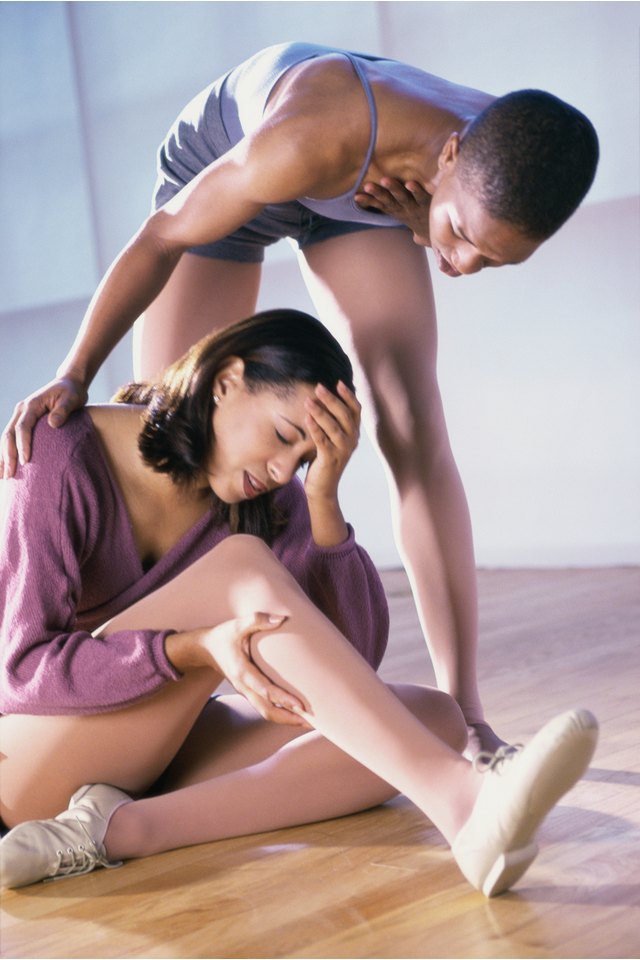How to Treat a Sore Achilles Tendon

According to the American Academy of Orthopedic Surgeons, the Achilles tendon is a fibrous band in the back of your heel that connects your leg muscles to bone. When you exercise, this tendon is prone to trauma and overuse, especially if you take part in activities that frequently stress your calf muscles, such as climbing and running. Your Achilles tendon can be sore for days or even weeks, and there are specific ways to address this.
Rest and avoid any activities that stress your calve muscles and Achilles tendon. For example, swim instead of run. An activity such as swimming does not pose a risk to your Achilles tendon.
Apply a cold compress to your sore Achilles tendon for 20 minutes at a time. Do this frequently throughout the day.
Wrap your entire ankle in an Ace bandage and use claw clips to secure it. Make sure the bandage is compressing your calve muscles. According to the Mayo Clinic, this can decrease any swelling over your Achilles tendon.
Use pillows to elevate your leg above your heart. This helps reduce swelling.
Stretch your Achilles tendon by moving your foot in all directions. For example, move your foot up and hold this position for 30 seconds. Repeat this for each foot direction, and do this slowly as your Achilles tendon is vulnerable to further injury.
Go to your pharmacy to obtain nonsteroidal anti-inflammatory drugs (NSAIDs) such as aspirin or ibuprofen. Read the package and use as directed. This can decrease the soreness in your Achilles tendon.
Warnings
Avoid using NSAIDs for longer than ten days. According to the Mayo Clinic, serious side effects of use include stomach bleeding, ulcers and stomach pain. Call your doctor if your pain persists despite NSAID use.
References
- American Academy of Orthopedic Surgeons
- Lopez RG, Jung HG. Achilles tendinosis: treatment options. Clin Orthop Surg. 2015;7(1):1-7. doi:10.4055/cios.2015.7.1.1
- Medina Pabón MA, Naqvi U. Achilles Tendonitis. Treasure Island (FL): StatPearls Publishing. Updated April 8, 2019.
- Tu P. Heel Pain: Diagnosis and Management. Am Fam Physician. 2018;97(2):86-93.
- Fakoya AOJ, Otohinoyi DA, Fakoya FA. Correlation of some predisposing intrinsic conditions with the morphological integrity of the Achilles tendon. Ann Afr Med. 2018;17(2):58-63. doi:10.4103/aam.aam_49_17
- Bass E. Tendinopathy: Why the Difference Between Tendinitis and Tendinosis Matters. Int J Ther Massage Bodywork. 2012;5(1):14-17.
- Gulati V, Jaggard M, Al-nammari SS, et al. Management of achilles tendon injury: A current concepts systematic review. World J Orthop. 2015;6(4):380-6. doi:10.5312/wjo.v6.i4.380
- Vyas S, Bhalla AS, Ranjan P, Kumar S, Kumar U, Gupta AK. Rheumatoid Arthritis Revisited - Advanced Imaging Review. Pol J Radiol. 2016;81:629-635. doi:10.12659/PJR.899317
- Kim J, Sung DJ, Lee J. Therapeutic effectiveness of instrument-assisted soft tissue mobilization for soft tissue injury: mechanisms and practical application. J Exerc Rehabil. 2017;13(1):12-22. doi:10.12965/jer.1732824.412
- Park YH, Jeong SM, Choi GW, Kim HJ. How early must an acute Achilles tendon rupture be repaired? Injury. 2017;48(3):776-780. doi:10.1016/j.injury.2017.01.020
- Maughan KL, Boggess BR. (2018). Achilles tendinopathy and tendon rupture. Fields KB, ed. Waltham, MA: UpToDate Inc.
Warnings
- Avoid using NSAIDs for longer than ten days. According to the Mayo Clinic, serious side effects of use include stomach bleeding, ulcers and stomach pain. Call your doctor if your pain persists despite NSAID use.
Writer Bio
Lisabetta Divita is a physician whose love for writing flourished while she was exposed to all facets of the medical field during her training. Her writings are currently featured in prominent medical magazines and various online publications. She holds a doctorate in medicine, a master's in biomedicine, and a Bachelor of Science in biology from Boston College.
